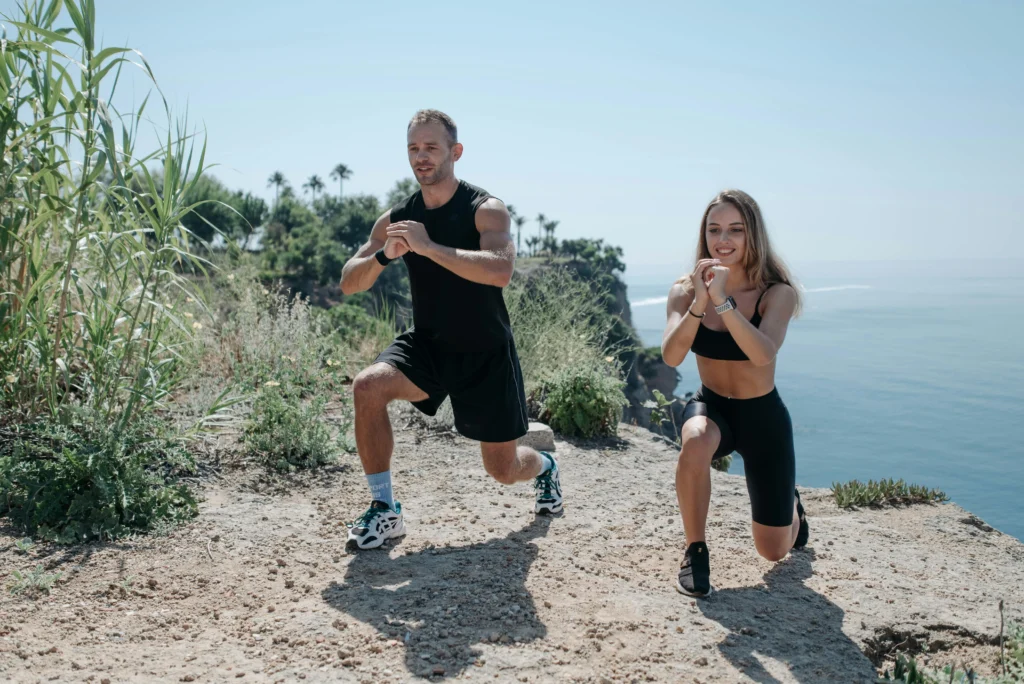Table of Contents
Introduction
Ease Fitness Aches: Fight Pain & Stay Active 2024 Are you tired of being sidelined by fitness-related aches and pains? Don’t let discomfort hold you back from staying active and achieving your fitness goals. In this article, we will explore effective strategies for fighting fitness-related aches and pains, helping you to ease pain and keep moving with ease. Whether you’re a seasoned athlete or just starting your fitness journey, these tips will help you stay active while managing and preventing pain.
From understanding the causes of fitness-related aches and pains to proper warm-up and cool-down techniques, and strengthening exercises to the importance of rest and recovery, we’ve got you covered. Discover how nutrition and hydration can play a role in pain management, and why proper form and technique are crucial in injury prevention.
Even if you encounter movements that cause pain, there are modifications and alternative options available to keep you on track. If the pain persists or becomes severe, seeking professional help and guided therapy can make a significant difference in your well-being.
Don’t let fitness-related aches and pains hinder your progress. Learn the strategies to fight back and stay active. Say goodbye to discomfort and hello to a more pain-free fitness journey.
Key Takeaways:
- Fighting fitness-related aches and pains is possible with the right strategies and techniques.
- Proper warm-up and cool-down routines can significantly reduce the risk of developing pain.
- Building strength and flexibility through exercises can help prevent aches and pains.
- Rest and recovery are crucial for avoiding overuse injuries and chronic pain.
- Proper nutrition and hydration can play a role in managing aches and pains.
Understanding Fitness-Related Aches and Pains

Before we can effectively combat fitness-related aches and pains, it’s important to understand their causes and impact. In this section, we will delve into common sources of aches and pains, as well as the effects they can have on your fitness journey.
Many fitness enthusiasts experience fitness-related aches and pains at some point in their journey. These discomforts can arise from various factors, including overuse, improper form, muscle imbalances, or even injury. By understanding the root causes, we can take proactive measures to address and prevent them.
Common Sources of Fitness-Related Aches and Pains
1. Muscle Soreness: Delayed onset muscle soreness (DOMS) is a common side effect of intense workouts or new exercises. It typically occurs within 24 to 48 hours after exercise and is characterized by stiffness and tenderness in the affected muscles.
2. Joint Pain: High-impact activities or repetitive motions can lead to joint pain, a common complaint among fitness enthusiasts. Conditions such as tendonitis, bursitis, or arthritis may contribute to joint discomfort.
3. Lower Back Pain: Improper form during exercises, particularly those that involve lifting or bending, can strain the muscles and ligaments in the lower back. Poor posture during both exercise and daily activities can also contribute to this type of pain.
4. Overuse Injuries: Repeating the same movement patterns without allowing adequate rest and recovery can lead to overuse injuries. These injuries often manifest as tendinitis, stress fractures, or strains.
The Impact of Fitness-Related Aches and Pains
Fitness-related aches and pains can have a significant impact on your overall fitness journey. They can cause discomfort, limit your range of motion, hinder progress, and even demotivate you to continue your fitness pursuits.
Understanding the effects of these aches and pains helps us appreciate the importance of addressing them. By actively managing and preventing fitness-related discomfort, you can maintain a consistent exercise routine and achieve your fitness goals.
“Pain is temporary. Quitting is permanent.” – Lance Armstrong
Proper Warm-Up and Cool-Down Techniques
Achieving your fitness goals is an exhilarating experience, but it’s essential to prioritize your body’s well-being along the way. One of the most effective ways to prevent fitness-related aches and pains is by incorporating proper warm-up and cool-down techniques into your exercise routine.
Warm-up techniques prepare your body for the upcoming physical activity by gradually increasing your heart rate, loosening your muscles, and enhancing your flexibility. This not only improves your performance during the workout but also reduces the risk of injuries and discomfort afterward.
Here are some important warm-up techniques to integrate:
- Dynamic stretching: Engage in active movements that mimic the exercises you will be doing, such as high knees, leg swings, or arm circles. This helps to increase blood flow and warm up your muscles.
- Cardiovascular exercise: Spend a few minutes engaging in light cardio activities like brisk walking, jogging, or cycling. This elevates your heart rate gradually, promoting blood circulation and oxygen delivery to your muscles.
- Joint mobilization: Perform gentle movements that target your joints, such as shoulder rolls, wrist circles, or ankle rotations. These help to lubricate the joints and improve their range of motion.
Once you complete your workout, it’s equally important to cool down properly to gradually bring your body back to a resting state. Cool-down techniques promote recovery, reduce muscle soreness, and prevent post-workout aches and pains.
Consider incorporating the following cool-down techniques:
- Static stretching: Hold stretches for various muscle groups, focusing on the areas you worked on during your workout. This helps to relieve tension, improve flexibility, and prevent muscle tightness.
- Foam rolling: Use a foam roller to target specific muscle groups and release any tightness or knots. This self-massage technique aids in muscle recovery and alleviates post-workout discomfort.
- Deep breathing: Take a few minutes to practice deep breathing exercises, inhaling slowly through your nose and exhaling through your mouth. This promotes relaxation and helps your body transition into a state of rest.
Incorporating these warm-up and cool-down techniques into your fitness routine can make a significant difference in preventing aches and pains. By allowing your body to properly prepare and recover from exercise, you’ll be able to enjoy your workouts to the fullest while minimizing the risk of discomfort or injury.
Strengthening and Stretching Exercises
Building strength and flexibility are crucial for preventing aches and pains during workouts. By incorporating targeted exercises into your fitness routine, you can enhance your overall performance while reducing the risk of discomfort.

Upper Body Strengthening
Strengthening exercises focused on the upper body can help alleviate common aches and pains in the neck, shoulders, and back. Try incorporating the following exercises into your workout:
- Push-Ups: This classic exercise targets the chest, shoulder, and tricep muscles, helping to improve upper body strength and stability.
- Plank: Holding a plank position engages the core muscles as well as the muscles in the shoulders and arms, promoting overall upper body strength.
- Dumbbell Rows: Using dumbbells, perform a rowing motion to target the back muscles, improving posture and reducing discomfort.
Lower Body Strengthening
Strong legs and glutes are essential for maintaining proper form and minimizing aches and pains in the hips, knees, and ankles. Consider adding the following exercises to your routine:
- Squats: This compound exercise targets the quadriceps, hamstrings, and glutes, providing a solid foundation for lower body strength.
- Lunges: Step forward or backward into a lunge position, engaging the leg and glute muscles while improving balance and stability.
- Deadlifts: Performing deadlifts with proper form helps strengthen the entire posterior chain, including the glutes, hamstrings, and lower back.
Stretching for Flexibility
Incorporating stretching exercises into your routine can increase flexibility, reduce muscle tension, and prevent aches and pains. Try the following stretches to improve your overall flexibility:
- Hamstring Stretch: Sit on the floor with one leg extended, and reach forward to touch your toes, feeling the stretch in the back of your leg.
- Quadricep Stretch: Stand tall and grab your ankle, pulling your foot towards your glutes to stretch the front of your thigh.
- Chest Stretch: Stand with one arm extended against a wall or door frame, and gently rotate your body away to stretch the chest muscles.
Remember to warm up your muscles before stretching and perform each exercise with controlled movements and proper technique. By incorporating strengthening and stretching exercises into your fitness routine, you can prevent aches and pains, allowing you to fully enjoy your workouts.
| Exercise | Targeted Muscles |
| Push-Ups | Chest, Shoulders, Triceps |
| Plank | Core, Shoulders, Arms |
| Dumbbell Rows | Back, Biceps |
| Squats | Quadriceps, Hamstrings, Glutes |
| Lunges | Quadriceps, Hamstrings, Glutes |
| Deadlifts | Glutes, Hamstrings, Lower Back |
Importance of Rest and Recovery
In any fitness routine, rest and recovery play a crucial role in preventing aches and pains. Your body needs adequate time to heal and regenerate after intense workouts, allowing your muscles and joints to recover. Without proper rest and recovery, you increase the risk of overuse injuries, chronic pain, and decreased performance.
Rest days and sufficient sleep are essential for your body to repair itself and restore energy levels. It’s during rest that muscle tissues rebuild and strengthen, reducing the likelihood of experiencing discomfort during your workouts.
Remember, while your body might crave continuous activity, pushing yourself too hard without giving it adequate rest can be counterproductive. So, listen to your body and honor the need for rest and recovery.
By including rest and recovery as an integral part of your fitness routine, you can experience numerous benefits. These include improved muscle growth, enhanced performance, reduced risk of injuries, and better overall well-being.
Active Recovery
While rest days are crucial, it’s important to note that recovery doesn’t always mean complete inactivity. Active recovery can be beneficial in preventing aches and pains by promoting blood circulation and alleviating muscle soreness. Engaging in low-intensity activities such as yoga, swimming, or gentle stretching can help loosen tight muscles and enhance overall flexibility.
Creating a Rest and Recovery Plan
To optimize rest and recovery, consider incorporating the following practices into your fitness routine:
- Schedule rest days: Plan regular days off from intense workouts to allow your body time to recover.
- Get enough sleep: Aim for 7-9 hours of quality sleep each night to aid in muscle repair and rejuvenation.
- Listen to your body: Pay attention to any signs of fatigue or pain. If you feel overly tired or experience discomfort during exercise, adjust your routine and take extra rest.
- Hydrate adequately: Drink enough water throughout the day to support optimal hydration, as dehydration can hinder recovery.
- Consider massage or foam rolling: These techniques can help release tension in muscles and improve blood flow.
Remember, rest and recovery are essential components of a healthy and sustainable fitness journey. By prioritizing these practices in your routine, you can prevent aches and pains, enhance your performance, and enjoy long-term fitness success.
| Benefits of Rest and Recovery | Practices for Optimal Rest and Recovery |
| Improved muscle growth | Schedule rest days |
| Enhanced performance | Get enough sleep |
| Reduced risk of injuries | Listen to your body |
| Better overall well-being | Hydrate adequately |
Nutrition and Hydration for Pain Management

When it comes to managing aches and pains in your fitness journey, what you consume plays a vital role. Proper nutrition and hydration can have a significant impact on your pain levels, helping you stay active and feeling your best.
Good nutrition is essential for supporting your body’s natural healing processes. Consuming a balanced diet rich in nutrients like vitamins, minerals, and antioxidants can promote tissue repair, reduce inflammation, and enhance overall recovery. Incorporate a variety of fruits, vegetables, whole grains, lean proteins, and healthy fats into your meals to provide your body with the necessary building blocks for pain management.
Hydration is equally important in pain management. Maintaining optimal hydration levels ensures that your body functions optimally, including the lubrication of joints and muscles. Proper hydration helps flush out toxins, improves blood circulation, and assists in the transportation of essential nutrients to the affected areas. Aim to drink plenty of water throughout the day, especially during and after workouts, to keep your body hydrated and aid in pain relief.
“Nutrition and hydration play a crucial role in managing pain and promoting healing. Choosing nutrient-dense foods and staying well-hydrated can have a positive impact on your overall well-being.”
Additionally, certain foods and beverages have specific properties that can help alleviate pain. For example, foods rich in omega-3 fatty acids, such as fatty fish, walnuts, and flaxseeds, have anti-inflammatory properties that can help reduce pain and inflammation in the body. Ginger and turmeric, known for their anti-inflammatory and analgesic effects, can also be beneficial in pain management. Including these foods in your diet can provide natural pain relief.
Here’s a table highlighting some nutrient-dense foods and their benefits for pain management:
| Food | Benefit |
| Fatty fish (salmon, mackerel) | Rich in omega-3 fatty acids, reduce inflammation |
| Walnuts | Contain omega-3 fatty acids, anti-inflammatory properties |
| Flaxseeds | Source of omega-3 fatty acids, anti-inflammatory effects |
| Ginger | Has anti-inflammatory and analgesic properties |
| Turmeric | Anti-inflammatory and pain-relieving effects |
Remember, nutrition and hydration are not only essential for pain management but for overall health and well-being. By making conscious choices about what you eat and drink, you can support your body’s natural healing processes and effectively manage aches and pains, allowing you to stay active and enjoy your fitness journey.
The Role of Proper Form and Technique
When it comes to exercise, proper form and technique play a crucial role in preventing injuries and ensuring optimal results. Many fitness-related aches and pains can be traced back to incorrect form, which puts unnecessary strain on the body. By understanding the importance of maintaining proper form during your workouts, you can minimize the risk of injury and even prevent discomfort altogether.
So, what exactly is proper form?
Proper form refers to the correct alignment and execution of exercises. It involves utilizing the right muscle groups, maintaining the ideal posture, and moving in a controlled manner. Whether you’re lifting weights, performing bodyweight exercises, or engaging in any other type of physical activity, using the proper form ensures that your body is functioning optimally and reduces the risk of strain or overexertion.
How does proper technique contribute to injury prevention?
When you use proper technique, you distribute the workload evenly throughout the body, reducing the likelihood of overloading certain muscles or joints. This balanced distribution of effort decreases the strain on individual body parts and minimizes the risk of acute or chronic injuries. By following proper form guidelines, you’ll also engage the targeted muscles more effectively, allowing for better muscle development and overall performance.
Incorrect form and technique can lead to unnecessary strain on your body, resulting in aches and pains.
Proper form and technique are especially important when performing exercises that involve heavy weights or complex movements. In these cases, a misalignment or improper technique can magnify the risk of injury. It’s essential to prioritize learning the correct form from the beginning or seek guidance from a qualified fitness professional to ensure you’re performing exercises correctly.
So how can you maintain proper form during your workouts?
Here are a few key tips to help you maintain proper form and technique:
Tips for Maintaining Proper Form
- Start with lighter weights or resistance to focus on proper technique and gradually increase intensity
- Pay attention to the proper alignment of your body, including the spine, hips, and limbs
- Engage your core muscles to provide stability and support
- Breathe rhythmically and avoid holding your breath
- Seek guidance from a fitness professional or trainer who can provide personalized instruction and corrections
Incorporating these tips into your workout routine will help you develop a strong foundation of proper form and technique. Remember, always prioritize the quality of movement over the quantity of repetitions. It’s better to perform exercises correctly with lower weights or intensity than to sacrifice form for the sake of heavier loads.
Discover the importance of maintaining proper form during exercise and how it can prevent injuries.
By focusing on proper form and technique, you can not only prevent injuries but also enhance the effectiveness of your workouts. So, the next time you hit the gym or participate in physical activity, pay attention to your form and execute your movements with intention and precision. Your body will thank you for it.
Modifications and Alternatives for Painful Movements
When it comes to fitness, it’s essential to listen to your body and make adjustments to your exercise routine when needed. Not all movements or exercises are suitable for everyone, and it’s important to find modifications and alternatives that allow you to stay active while avoiding further discomfort. By making these adjustments, you can effectively manage pain and continue on your fitness journey.
Modifications for Painful Movements
Modifications are changes made to the original movement to make it more manageable and less painful. These modifications can help reduce strain and prevent exacerbating existing pain. Here are some common modifications for different types of exercises:
- Weightlifting: Decrease the weight or use resistance bands to reduce the load on your joints and muscles.
- Cardiovascular exercises: Choose low-impact options like swimming or cycling instead of high-impact movements that may cause pain.
- Yoga: Use props like blocks and straps to modify poses to suit your comfort level. You can also try restorative yoga, which focuses on gentle stretching and relaxation.
Remember, modifications are all about finding what works best for you. It’s important to consult with a fitness professional or physical therapist who can guide you in making the right modifications for your specific needs and goals.

Alternatives for Painful Movements
If a particular movement consistently causes pain or discomfort, it may be necessary to find alternative exercises that target the same muscle groups or achieve a similar effect. Here are some alternative options for common exercises:
- Squats: If regular squats cause knee pain, consider trying wall squats or using a stability ball against the wall for support.
- Running: If running is too jarring for your joints, try low-impact exercises like elliptical training or swimming to get your cardiovascular workout.
- Planks: If traditional planks strain your wrists or shoulders, modify them by doing forearm planks or using a stability ball to reduce pressure on those areas.
By exploring alternative exercises, you can find movements that accommodate your needs while still engaging the targeted muscles and achieving your fitness goals.
Remember, pain management and staying active go hand in hand. Use modifications and alternative exercises to find a balance that allows you to continue working towards your fitness objectives without exacerbating pain or risking further injury.
| Exercise | Painful Movement | Modification | Alternative |
| Weightlifting | Heavy weights exacerbating joint pain | Reduce weight or use resistance bands | Try low-impact exercises like Pilates |
| Running | Knee pain during running | Shorten stride and focus on form | Switch to low-impact cardio exercises like cycling |
| Planks | Wrist discomfort during traditional planks | Do forearm planks or use a stability ball | Try side planks or bird dogs for core strengthening |
Remember, it’s important to consult with a healthcare professional or fitness expert before implementing any modifications or alternative exercises. They can provide personalized guidance based on your specific pain management needs and fitness goals.
Seeking Professional Help and Guided Therapy
Sometimes, maintaining proper form and following preventive measures may not be enough to fully address persistent or severe fitness-related aches and pains. In such cases, it is crucial to seek professional help to effectively manage and alleviate your discomfort. Seeking professional assistance can provide valuable insights and customized treatment options that cater to your specific needs.
Professional help in pain management can come in various forms. One option is to consult with a physiotherapist or a sports medicine specialist who specializes in treating fitness-related injuries. These healthcare professionals have extensive knowledge and experience in diagnosing and treating musculoskeletal conditions.
Guided therapy is another option to consider. This approach involves working closely with a trained professional who will guide you through targeted exercises and techniques designed to address your pain and help you regain optimal functionality. By working with a guide, you can receive personalized attention, ensuring that your therapy is tailored to your unique circumstances.
One popular guided therapy method is physical therapy. Physical therapists are specialized healthcare professionals who use various techniques, exercises, and hands-on manipulation to promote mobility, improve functionality, and alleviate pain. They can provide you with a personalized treatment plan and guide you through the rehabilitation process.
Another form of guided therapy that may be beneficial is occupational therapy. Occupational therapists specialize in helping individuals regain independence in their daily activities, such as work and self-care, after an injury. They can offer valuable guidance and techniques to manage pain and minimize its impact on your daily life.
In some cases, seeking professional help may involve additional healthcare providers, such as chiropractors, massage therapists, or acupuncturists. These alternative therapies can complement traditional approaches and offer a holistic perspective on pain management.
Remember, seeking professional help and guided therapy for your fitness-related aches and pains is an essential step toward finding relief and improving your overall well-being. The expertise and guidance provided by trained professionals can help you navigate your pain effectively while promoting a safe and sustainable fitness journey.
| Treatment Option | Description |
| Physiotherapy | A healthcare profession that focuses on diagnosing and treating musculoskeletal conditions through exercises, manual therapy, and other techniques. |
| Physical Therapy | A form of guided therapy led by physical therapists, who design personalized treatment plans to improve mobility and alleviate pain. |
| Occupational Therapy | Additional therapeutic approaches, such as chiropractic care, massage therapy, and acupuncture, can complement traditional treatment methods. |
| Alternative Therapies | Additional therapeutic approaches, such as chiropractic care, massage therapy, and acupuncture, that can complement traditional treatment methods. |

Conclusion
In conclusion, implementing the strategies discussed in this article empowers you to effectively combat fitness-related aches and pains, allowing you to stay active and fully embrace your fitness journey. By prioritizing proper warm-up and cool-down techniques, engaging in strengthening and stretching exercises, recognizing the importance of rest and recovery, nourishing your body with proper nutrition and hydration, maintaining proper form and technique, and seeking professional guidance when needed, you can take control of your pain and keep moving with ease.
Remember, understanding the causes and impact of fitness-related aches and pains is the first step toward prevention and management. By staying proactive and mindful of your body’s needs, you can minimize discomfort and maximize your overall fitness experience. So, don’t let pain hold you back – embrace the strategies outlined in this article and embark on a pain-free fitness journey today!
Thank you for reading and we hope that the information provided has been valuable to you. Stay active, stay fit, and enjoy the benefits of a healthy and pain-free lifestyle!
FAQ
How can I fight fitness-related aches and pains?
To fight fitness-related aches and pains, you can follow strategies such as proper warm-up and cool-down techniques, strengthening and stretching exercises, taking rest and recovery periods, focusing on nutrition and hydration, maintaining proper form and technique, modifying or finding alternatives for painful movements, and seeking professional help or guided therapy when needed.
Why is it important to understand fitness-related aches and pains?
Understanding fitness-related aches and pains is crucial because it allows you to identify their causes, assess their impact on your fitness journey, and take appropriate measures to prevent or manage them effectively.
What are some proper warm-up and cool-down techniques I can practice?
Some effective warm-up techniques include dynamic stretching, light cardio exercises, and joint mobility exercises. For cool-down, focus on static stretching, gentle movements, and deep breathing exercises.
How can strengthening and stretching exercises help in preventing aches and pains?
Strengthening exercises help improve muscle strength and stability, reducing the risk of overuse injuries and discomfort. Stretching exercises increase flexibility and mobility, preventing muscle stiffness and reducing the likelihood of pain after workouts.
Why is rest and recovery important in a fitness routine?
Rest and recovery allow your body time to repair and regenerate after intense workouts. By giving your muscles and joints the necessary rest, you can prevent overuse injuries, reduce inflammation, and manage aches and pains more effectively.
How does nutrition and hydration affect pain management?
Proper nutrition and hydration play a vital role in managing aches and pains. Nutrient-rich foods provide essential vitamins and minerals for tissue repair while staying hydrated helps maintain joint lubrication and reduce muscle soreness.
Why is it important to maintain proper form and technique during exercise?
Maintaining proper form and technique helps minimize stress on your body, reducing the risk of aches and pains. It ensures optimal muscle engagement, prevents compensatory movements, and promotes efficient movement patterns.
What can I do if certain movements or exercises are causing me pain?
If certain movements or exercises are causing pain, it’s essential to modify them or find suitable alternatives. You can consult a fitness professional or physical therapist who can provide personalized recommendations based on your specific needs and limitations.
When should I seek professional help for fitness-related aches and pains?
It is advisable to seek professional help when you experience persistent or severe fitness-related aches and pains that limit your ability to perform daily activities or hinder your fitness progress. A healthcare professional or therapist can diagnose the issue and offer guided therapy to manage and alleviate your pain effectively.
How can I effectively fight fitness-related aches and pains?
By implementing the strategies discussed in this article, such as proper warm-up and cool-down techniques, strengthening and stretching exercises, rest and recovery, nutrition and hydration management, maintaining proper form, modifying or finding alternatives for painful movements, and seeking professional help when needed, you can effectively fight fitness-related aches and pains, enabling you to stay active and enjoy your fitness journey.
